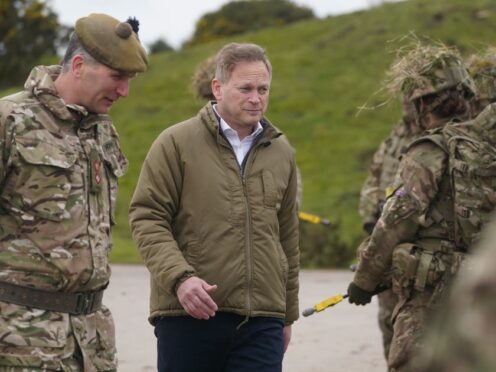
The Defence Secretary has called for military spending to be increased to 3% of GDP in a debate about the funding of Britain’s armed forces.
Speaking on a visit to Poland, Grant Shapps called for the inclusion of the 3% target in the Conservatives’ election manifesto, saying: “I want a bigger budget.”
He also called for an overhaul of recruitment, including an end to certain medical requirements and a lifting of the ban on soldiers growing beards, the Daily Mail reported.
Mr Shapps said: “I have coined the phrase ‘moving from post-war to pre-war’. We have to be much better prepared.
“Defence is the best way to protect ourselves against a military conflict – you have to show your adversaries – so I am clearly in favour (of a 3% target). We live in a more dangerous world, we’ve got Putin on the front line making gains.”
Research by the Royal United Services Institute in 2022 suggested that increasing defence spending to 3% of GDP by 2030, as suggested by Liz Truss’s government, would require £157 billion in additional spending over the following eight years.
Mr Shapps’ call follows demands from security minister Tom Tugendhat and Foreign Office minister Anne-Marie Trevelyan that spending rise from 2.27% of GDP to 2.5% immediately.
Last week’s Budget contained no new money for defence despite concerns about the state of Britain’s armed forces and the Government’s commitment to spend 2.5% of GDP on the military “as soon as economic conditions allow”.
That decision has drawn criticism from some quarters, including former service chiefs such as Lord Stirrup, who served as chief of the defence staff between 2006 and 2010, and warned on Tuesday that basing military spending on the financial climate rather than threats to national security was not “any kind of prudent”.
Mr Shapps also said he wanted to see changes to recruitment processes that currently see applicants wait more than a year to begin training at a time when more people are leaving the armed forces than joining.
He said: “You can be rejected for the most ludicrous reasons. Medical tests will ask about family history and if they think in 40 years’ time you might develop some diseases, using actuaries, then they’ll say you cannot serve today.
“They’re probably not going to be serving in 40 years’ time.
“Who cares if somebody has got a bear? Does that really mean you cannot fight? Come on, we are living in the 21st century, it is time to move on.”

Enjoy the convenience of having The Sunday Post delivered as a digital ePaper straight to your smartphone, tablet or computer.
Subscribe for only £5.49 a month and enjoy all the benefits of the printed paper as a digital replica.
Subscribe